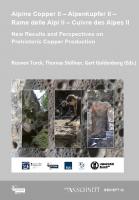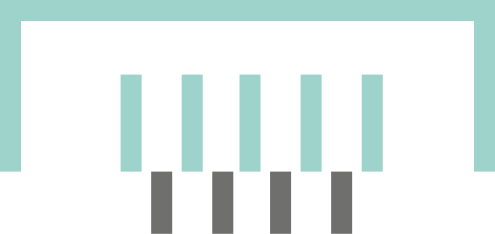Alpine Copper II – Alpenkupfer II – Rame delle Alpi II – Ciuvre des Alpes II. New Results and Perspectives on Prehistoric Copper Production
Schlagworte:
alpine Kupfergewinnung, Metallprovenienzstudien, Bergbau, soziale Interaktionen, räumliche Interaktionen, Technologie, Handel, prähistorische VerhüttungÜber dieses Buch
Die Erschließung der Kupfervorkommen in den alpinen Gebirgsregionen erlangte vor allem im 2. und 1. Jahrtausend v.Chr. eine enorme wirtschaftliche Bedeutung, da alpines Kupfer für die Metallversorgung Europas eine zentrale Rolle spielte. Der vorliegende Band resümiert den aktuellen Forschungsstand zur prähistorischen alpinen Kupfergewinnung von den Westalpen und Südalpen bis vor die Tore Wiens in den Ostalpen. Die 23 Beiträge hervorgegangen aus einer im September 2016 veranstalteten Tagung an der Universität Innsbruck umfassen die Themen Montanlandschaft, Bergbau, Aufbereitung, Verhüttung und Metallhandel in der Bronzezeit und frühen Eisenzeit. Ein zentrales Forschungsunternehmen kommt im vorliegenden Band in besonderer Weise zu Wort, nämlich das 2014 bis 2018 von Partnern in Deutschland, Österreich und der Schweiz durchgeführte D-A-CH-Projekt „Prehistoric copper production in the Eastern and Central Alps technical, social and economic dynamics in space and time“. Die Autor*innen des Bandes stellen die Fahlerzproblematik und die verschiedenen technischen Prozesse im Rahmen einer allgemeineren „chaîne opératoire“ in ein neues Licht. In Umrissen lässt sich schon heute erkennen, wie unterschiedlich einzelne alpinen Regionen allgemeinere technische und wirtschaftliche Konzepte rund um die Kupfergewinnung adaptiert haben.
Kapitel
-
Front matter and content
-
Preface
-
Enmeshment within resource-scapes – Eastern Alpine copper production of the Bronze and Early Iron Age
-
Bronze Age copper production in Kitzbühel, Tyrol
-
Prehistoric copper production in Lower Austria – A new assessment
-
A methodology to integrate information in prehistoric mining archaeology research
-
Early Bronze Age copper extraction(s) in the Grandes Rousses Massif (Isère and Savoy departments, France)
-
Prehistoric mining in a small medieval mining district in Montafon, Vorarlberg (Austria)
-
Prospecting for copper – Mineralogical and first mining archaeological surveys in western North Tyrol, Austria
-
Late Bronze Age/Early Iron Age fahlore mining in the Lower Inn Valley (North Tyrol, Austria)
-
Mineral-chemical characterisation of chalcopyrites and fahlore-group minerals from selected Cu-ore deposits in the Eastern Alps
-
Between mining and smelting in the Bronze Age – Beneficiation processes in an Alpine copper producing districtResults of 2008 to 2017 excavations at the “Sulzbach-Moos”-bog at the Mitterberg (Salzburg, Austria)
-
Some provisional results of experiments undertaken using a reconstructed sluice box an attempt to try and reproduce the methods of washing and concentrating chalcopyrite at the Middle Bronze Age ore processing site of Troiboden, Mitterberg, Austria
-
Organising smelting places. A keynote on Iron Age copper smelting in the Oberhalbstein (Canton of Grisons, Switzerland)
-
Copper smelting slag from the Oberhalbstein (Canton of Grisons, Switzerland)Methodological considerations on typology and morphology
-
Dendrochronological dating of charcoal from high-altitude prehistoric copper mining and smelting sites in the Oberhalbstein Valley (Grisons, Switzerland)
-
Bronze Age copper ore mining and smelting in Trentino (Italy)
-
The Late Bronze Age smelting site Rotholz in the Lower Inn Valley (North Tyrol, Austria)
-
Encapsulated industrial processes: slag-tempered ceramics and its implications for prehistoric metallurgy in the Lower Inn Valley (North Tyrol, Austria)
-
Slag heap quantification: re-evaluating the Mitterberg smelting sites
-
Metallographic analyses from the late Urnfield period copper mining settlement at Prigglitz-Gasteil in Lower Austria
-
Copper and bronze axes from Western Austria reflecting the use of different copper types from the Early Bronze Age to the Early Iron Age
-
Composition and spatial distribution of Bronze Age planoconvex copper ingots from Salzburg, Austria:First results from the “Salzburger Gusskuchenprojekt”
-
Recording plano-convex ingots (Gusskuchen) from Late Bronze Age Styria and Upper Austria – A short manual for the documentation of morphological and technological features from production and partition
-
The metal analyses of the SSN-project (with catalogue)
-
Peer-reviewers of this volume





